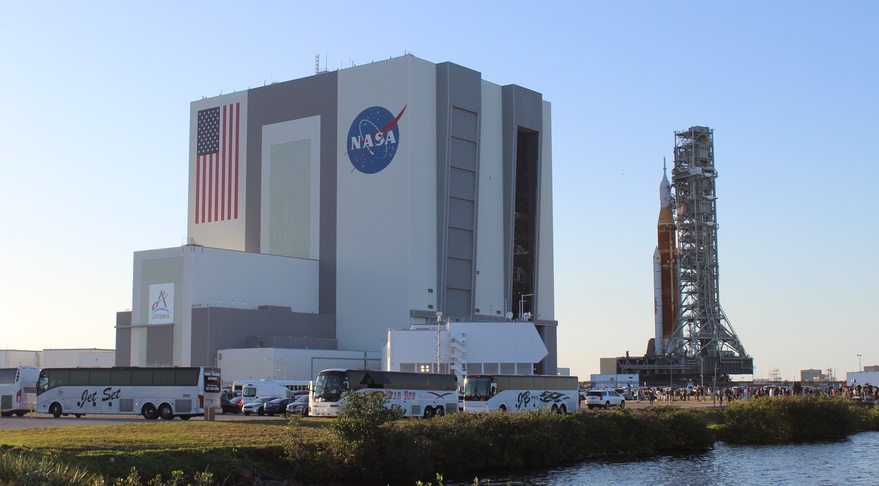WASHINGTON — NASA managers said a rollback of the Space Launch System from its launch pad after three truncated countdown tests will allow them to address issues both at the pad and with the vehicle, but that it was too early to predict what it would do to the schedule for the vehicle’s first launch.
NASA announced late April 16 that it would roll back the SLS from Launch Complex 39B to the Vehicle Assembly Building (VAB). Doing so, the agency said then, would give them time to improve the supply of nitrogen gas at the pad that caused issues with two of the three tanking tests.
The announcement came as something of a surprise, since at a briefing a little more than 24 hours earlier, NASA managers expressed optimism about finding the source of a hydrogen leak that scrubbed the third countdown attempt April 14. They predicted then that they could make another attempt to fuel the core stage with liquid hydrogen and liquid oxygen propellants and go through a countdown as soon as April 21.
The need to correct the nitrogen gas issue at the pad prompted the change in plans, said Charlie Blackwell-Thompson, NASA Artemis launch director, in an April 18 call with reporters. There were problems with the supply of the gas both at the start of propellant loading operations and also after the scrub, when the core stage was drained.
“When we looked at the timelines associated with that and we took that new data,” she said of the nitrogen upgrades, “it did cause us to look at what we could get done at the pad and did it make sense to stay at the pad.” The decision, she said, was to move the SLS back to the VAB while crews upgrade the nitrogen system.
That upgrade involves bringing into operation new equipment at a facility just outside the Kennedy Space Center. “Those are already at the plant. They’re already installed. It’s just a matter of tying them in,” she said. That work doesn’t affect other sites at the center, like neighboring Launch Complex 39A, that also use nitrogen gas for launch operations.
The new equipment provides a “more robust capability” for providing the larger volumes of nitrogen gas needed for SLS applications such as purging umbilical lines, said Tom Whitmeyer, NASA deputy associate administrator for common exploration systems development.
Agency officials did not identify the company that provides the nitrogen used at the center, referring to it as only the “nitrogen supplier.” However, Air Liquide operates a plant just outside the KSC gates that generates nitrogen that is fed by pipeline to various launch pads and other center facilities, according to a NASA website.
Workers are now preparing to roll back the SLS and its mobile launch platform to the VAB, with the move from the pad to the building tentatively scheduled for April 26, depending on weather. Once in the VAB, technicians will work to both fix the hydrogen leak found in the April 14 test and fix a faulty helium check valve in the rocket’s upper stage.
Blackwell-Thompson said initial checks at the pad failed to identify the source of the hydrogen leak in mobile launcher. Additional work to locate the leak will wait until after the vehicle returns to the VAB.
How long the SLS will remain the VAB remains to be seen. A “quick turn” option would focus on repairing the hydrogen leak and replacing the check valve before rolling back out to the pad for another wet dress rehearsal. A second option would add some additional work that NASA needs to complete before SLS is ready for launch that had been planned for after the wet dress rehearsal. A third option would get the vehicle ready for flight in the VAB, then roll out for a wet dress rehearsal followed by the Artemis 1 launch itself.
NASA officials said they had yet to decide which option to pursue or schedule implications of those options. Blackwell-Thompson said it was too early to estimate a minimum amount of time the SLS would remain in the VAB before rolling back out. The first option would likely have the vehicle in the VAB “in the weeks kind of timeframe,” she said.
The rollback, though, makes it unlikely the SLS would be ready to launch in a window that runs from June 6 to 16. “The earlier June window is challenged at this point,” Whitmeyer said. The next window opens June 29 and runs through July 12, with a cutout between July 2 and 4.
He emphasized, though, that NASA would carry out a full-scale tanking test and practice countdown before attempting a launch. “We’re absolutely going to do a wet dress rehearsal,” he said. “It’s just a matter of what’s the right time and what’s the right way to do that.”
